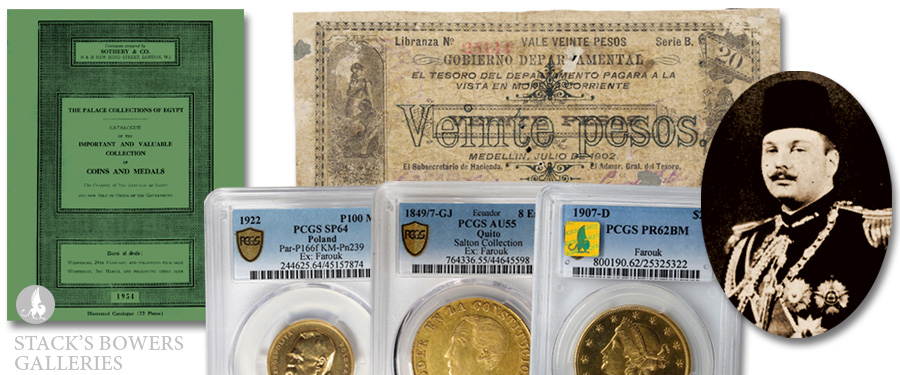
One of the most famous coin collectors in history, King Farouk I of Egypt (1920-1965) was a very active numismatist who amassed perhaps the greatest coin collection ever assembled. His collection contained many rarities, highlighted by an extensive United States collection, which included the only 1933 double eagle in private hands. When the Egyptian monarchy was overthrown in July 1952, King Farouk went into exile and the Egyptian government took possession of the collection. Less than two years later, in early 1954, the British auction firm Sotheby’s sold 2,798 lots in Cairo over the span of 11 days. Known as the Palace Collection of Egypt, to this day the auction is regarded as one of the ultimate events in numismatic history.
The sale was painstakingly put together by Sotheby’s employee John Synge, who spent 11 months preparing the auction catalog. Only a fraction of the items were photographed; most lots offered more than a single item with little regard for rarity. For example, the now famous 1933 double eagle was presented in a mixed lot of 17 $20 gold pieces, including other great rarities. While the lot was the highest grossing in the sale (hammering at 2,800 Egyptian Pounds, or about $8100 at the time) this price represents a fraction of the many millions of dollars the same coins would bring at auction today.
While collectors may know that King Farouk collected paper money, less well known is that this auction offered paper currency as well. During the last session, on March 6, 1954, the final lots of the sale (2501 – 2798) were presented. At the tail end of the day, even after the “miscellaneous items” were sold, “the collection of bank notes” (lots 2743 to 2798) crossed the auction block. The notes were grouped primarily by country or region, with certain lots featuring a large number of notes from a specific region. The notes were not described very well, and unfortunately no serial numbers were recorded. A typical description of paper money in the sale is lot 2752, which offered paper money from Estonia, Lithuania, Latvia and Finland:
Estonia, various (11); Latvia, various (24); Lithuania, various (7); Finland, various issues (48) 1886-1945, including 500, 100, 50, 20 and 10 marks 1945. Mostly in used condition.
This blog post would end there as this catalog did not include enough information to identify individual notes. However, there is one more source. Most notes in lot 2768, which offered “South and Central America, Mexico, Etc.” were auctioned again in the August 21-23, 1972 Almanzar’s sale, held in San Antonio, TX. That auction, which featured the “King Farouk Collection of Latin American Banknotes” is much better cataloged, even including serial numbers of most notes. The introduction of the catalog explains the path the notes took after the Farouk sale:
“A large portion of King Farouk’s paper money collection was acquired by the late Robert Franklin Schermerhorn at the fabulous Palace sale in Cairo…the executor of his estate sold the Latin American paper money section intact to Mr. Thomas C. Bain of Dallas.”
Lot 2768 in the Farouk sale included 857 notes (in a single lot), while 1,062 lots comprised the world paper money section of the Almanzar’s sale. Unfortunately, the catalog does not specify exactly which lots came from the Farouk sale. We can (obviously) exclude the notes printed after 1954, which lowers the number a bit. We can also exclude the non-Latin American notes (although not with 100% certainty). After that, however, it gets murky. Sixteen notes of Venezuela were included, for example, and sixteen lots of Venezuela are in the Almanzar’s catalog, but that includes a note dated 1955 (which couldn’t have been in the Farouk sale) and a lot which offered three notes.
At Stack’s Bowers Galleries we are no stranger to offering coins pedigreed back to the Farouk Collection. Likewise, sometimes we come across notes that are pedigreed to the Almanzar’s sale (for example in the upcoming ANA auction, where we offer a Colombia note sold in the 1972 sale). It is difficult not to wonder if such a note was at one point part of the King Farouk collection. Chances are fairly good that it was, but that’s as sure as we are going to get, until someone finds the original auction contracts from 1972 (the last Almanzar’s sale took place in 1984) or a scratch book from 1954 where someone painstakingly took down the serial numbers of the notes in the Palace Collection sale. Unfortunately, at this point, both are unlikely, but one can always hope.
Note: Both catalogs of the Palace Collections of Egypt from 1954 and the 1972 Almanzar’s sale can be found on the Newman Numismatic Portal.





